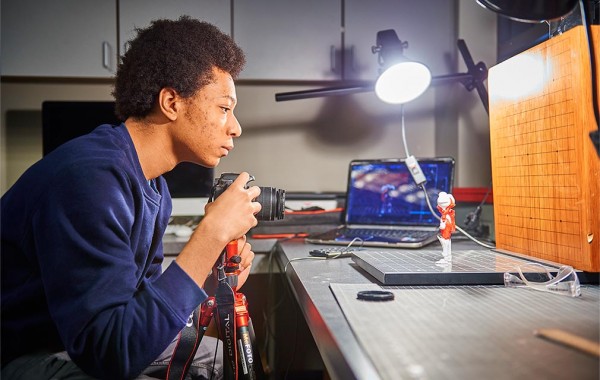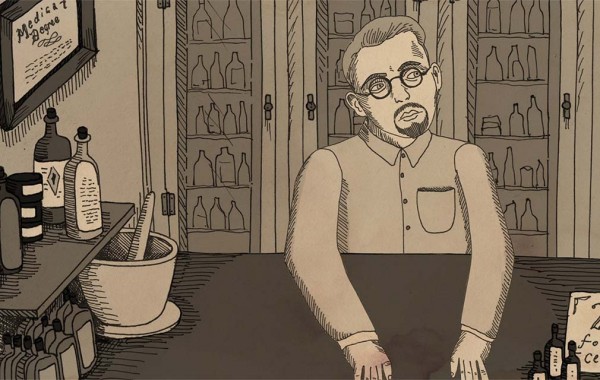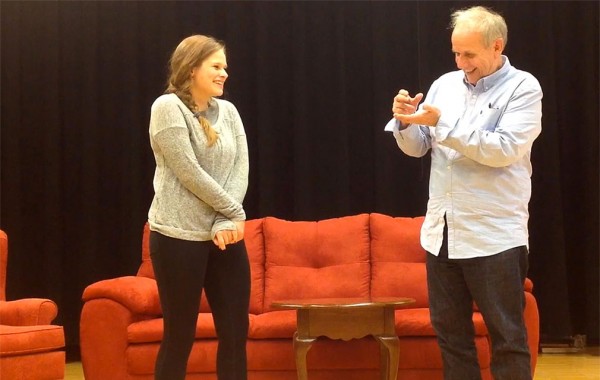Pecking at the feminine ideal
Under the light of a disco ball, dancers adorned in feathers and fishnets performed Bird Suite, a show that explored themes of female sexuality and gender roles. Two Colgate student dancers and a fitness instructor joined members of the New York City professional dance company SoGoNo for the October performances in Brehmer Theater.
“Bird Suite is sexy, fun, and also makes you think,” said director Tanya Calamoneri, a visiting assistant professor of theater who founded SoGoNo in 2003. “I think of birds as being very alien, and a lot of times women get that designation of other, as an exotic creature put on a pedestal. I started unpacking those metaphors and social tropes in the performances.”
Various aspects of female sexuality were woven throughout. For example, the second act, a duet titled “Flamingo Flamingo,” showed “the metamorphosis of socialization, recognizing the appeal and also the projections that are placed on [women] based on what they look like,” Calamoneri explained. In the third act, “Ain’t No Swan Lake,” four elegant swans sized each other up.
“[Bird Suite] questions who we perform for, how we police performances of gender and sexuality, and how we nudge the line of socially acceptable behavior,” Calamoneri explained.
Em Rubey ’18 related her role in this production to her personal experience. “Growing up dancing, I was always in a tutu or skirt of some sort, performing a very feminine ideal,” she said. “It was a great experience to be on stage performing a masculine understanding of gender and exploring the ways female masculinity informs my own performance of gender in everyday life. Through Bird Suite, I realized that, just like performing genders, there are many ways to perform dance.”
Calamoneri said she is “having fun stretching [students’] definitions of dance.”
Allison Spanyer ’16, another student dancer, said: “Seeing dance done in this way reminds me of why I want to go into the arts. There is so much room for creativity and play.”
— article by Jessica Rice ’16, photo by Nick Gilbert ’18
Class clowns
Typically, when you think of a clown, you conjure up an image of a red nose, exaggerated face paint, and floppy shoes. Steen Haakon Hansen, who visited from Denmark in October, is much more understated than his title suggests. A clown and master improviser, Hansen spent a week in classes and workshops with theater students.
Considered one of the best acting teachers in his field, Hansen began his work with Colgate students by helping them “feel safe in front of other people, so they can let loose,” he said, because improvisation takes courage. “As an actor, you can hide behind a character. But when you are improvising and you’re not trained, you’re naked. It’s you, and it’s scary.”
Clowns are natural improvisers who “take chances and are not afraid of getting into trouble; actually, that’s their business,” Hansen said.
During the week, Hansen’s workshops incorporated the basic premises of improvisation: for example, saying “yes” to every suggestion presented; and the circle of expectations, “which means that if I say two men are sitting in a boat, the audience will expect something that has to do with two men sitting in a boat and they start to follow that story.”
Imagination and storytelling are key abilities for these loosely structured exercises. “There are no limits, because I believe that there are stories in everything,” Hansen said.
Theater major Tanner Holley ’16 said that the free exploration resulted in “some really funny scenes.” He added: “He taught me to trust that I would save myself, even when I had no idea what I was going to say or do next.” Holley’s academic adviser, Professor April Sweeney, invited Hansen to campus.
One scenario the students explored was a birthday party. The participants secretly assigned characteristics to each other and treated them accordingly — sidling up to someone who is “attractive,” laughing at someone who is “funny,” being nervous around a person who is “dangerous.” Developing relationships with each other in the moment, the students learned to create stories together.
“You have to be a writer, an active performer, and a stage director, all at the same time,” Hansen said.
After each workshop, Hansen encourages students to verbalize their experience, strengthening the lesson for everyone. “You might say something that is very profound to another person,” he explained.
YouTube battles powered by art and technology

David (D.J.) Jordan ’17 takes a photo of a 3D model he created to test for use in his stop-motion animation projects. Photo by Andrew M. Daddio
David (D.J.) Jordan ’17 has created a cult following — with handmade, stop-motion homages to all things anime and gaming.
With more than 9.2 million views and 17,000 subscribers to his YouTube page, Jordan’s PilotTails animations are a labor of love. His 18-minute, 28-second opus Super Saiyans vs. Super Hedgehogs 2, in which action figures from the animated series Dragon Ball Z and Sonic the Hedgehog square off in battle, is composed of 16,620 individual frames (15 per second). When the frames are played quickly in succession, the illusion of movement is created much like a flip book. The special effects in the video were the result of a collaboration with Guilherme Fernandes (a.k.a. Zylladys Live FX), a YouTuber from Brazil.
“It’s really learn as you go,” said Jordan, who first started experimenting with stop-motion photography as a Prep for Prep high school student in his dorm room at Phillips Academy in Andover, Mass. He has steadily improved his technique with each production, using ever-more sophisticated camera equipment, digital effects, and specialized software called DragonFrame.
“It’s all geeky stuff, but I’m not ashamed about it. Now, a lot more polish goes into the animation. It’s not just knowing how figures work, but how motion works with momentum and the things you don’t see with the naked eye,” Jordan said, adding that his classroom experience with Wenhua Shi, assistant professor of art and art history, has helped improve the quality of his work.
After new 3D printers were installed in Case Library last year, Jordan began designing and printing out individual action figure parts to assemble into a fully articulated model of Samus Aran, heroine of the Metroid video game series, which he used in a screen test battle with a 3D-printed Link from Zelda.
Stop motion isn’t new. The original 1933 King Kong was animated in large part thanks to the technique, and Ray Harryhausen’s creations in Jason and the Argonauts (1963) and Clash of the Titans (1983) made the effect world famous. Today, films like Tim Burton’s The Nightmare Before Christmas (1993) and the claymation of Wallace and Gromit and Shaun the Sheep continue the stop-motion tradition.
With two influential internships now under his belt — one at the New York City architecture firm Diller Scofidio and Renfro, and another with The Foundation Center, a nonprofit organization where he helped develop computer animations — Jordan said he clearly sees how he may apply his skills to a career after college, working in either animation or architecture.
“I found a similar level of creativity and control with architecture,” said the studio art major. “It’s a concept-to-form idea that I also see in animation. Maybe that will be a more feasible extension of the things I like to do.”
Penny Lane goes to Sundance

NUTS! tells the outlandish story of John Romulus Brinkley, who offered a cure for impotence in 1917 by transplanting goat testicles.
A new documentary film by art and art history professor Penny Lane premiered at the Sundance Film Festival in January. NUTS! tells the outlandish story of John Romulus Brinkley, who offered a cure for human male impotence in 1917.
The New York Times, citing the festival’s lineup guide, reported, “In keeping with a recent trend in documentary filmmaking, nontraditional, sometimes controversial storytelling techniques will be on full display [at Sundance]… . The director Penny Lane, for instance, uses animated re-enactments and ‘one seriously unreliable narrator’ to trace the ‘mostly true’ story of a man who found success selling a goat-testicle impotence cure.”
Lane traveled the hemisphere in search of background information for NUTS! Her expeditions — and the film itself — were funded by the New York State Council on the Arts, Creative Capital, the Tribeca Film Institute, the Colgate University Research Council, and a Kickstarter campaign that yielded $80,000.
Her previous credits include Our Nixon, a documentary featuring home movies shot by President Richard Nixon’s aides, and The Voyagers, a short film about “two small spacecraft, an epic journey, taking risks, and falling in love — also, Carl Sagan.”
Movie makers and shakers
Sit back, relax, and enjoy the show. With so many Colgate alumni in the film industry, there’s a chance that a Raider played a role in getting that film on the screen. We bring you three alumni in the film news this fall.
Adam Paul ’89 founded and directed the St. Lawrence International Film Festival, held in four cities from October 22 to 25. Spanning the U.S.-Canada border, it was the first festival to be truly international. Held in Canton and Potsdam in New York and Ottawa and Brockville in Ontario, the festival attracted approximately 1,000 people — no small feat for an inaugural year.
The opening gala included a 35th-anniversary screening of The Blues Brothers at the Canadian Museum of History, which included a special guest appearance by Dan Aykroyd, the film’s co-creator and one of its stars. The other events featured 25 films (most of which were premieres), seven panels, and eight special screenings.
“We presented a world-class event to a region that had never seen anything like it before. Now we’ve got to do it again!” said Paul, who has already begun planning next year’s events.
R. Stephen Suettinger ’96 is the director, co-writer, and producer of A Year and Change, an independent feature film by his production company, Pebble Hill Films. It was featured in several 2015 festivals including L.A.’s Dances with Films. Recently acquired by Vision Films, A Year and Change is now available on video-on-demand services such as Amazon and iTunes, as well as DVD.
“After nine years of working to get this story told, we’re elated that we finally have the opportunity to get A Year and Change in front of audiences,” Suettinger told IndieWire. The movie tells the story of a vending-machine proprietor who decides to change his life after he falls off a roof during a New Year’s Eve party.
Trey Nelson ’98 wrote and directed his first feature film: Lost in the Sun, an action and drama open-road adventure that stars Josh Duhamel. When a young boy’s mother dies, Duhamel’s character offers the boy a ride to his grandmother’s house. The two quickly bond, but the man is a petty crook who soon involves the boy in a string of crimes across the nation. Lost in the Sun was released in theaters and video on demand on November 6.
— Meredith Dowling ’17







